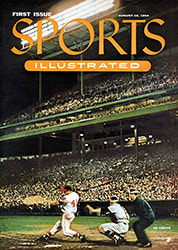YOU SHOULD KNOW if you are going to buy a puppy
You will be the newest of 17 million U.S. dog owners, most—but not all—of them happy in their choice of pets. You need not take a chance. The following information will help you select a dog that fits your specific needs.
Dogs and kids
This is an explosive question. No one agrees, and there can be no hard and fast rule that certain breeds are good with children and others bad—it depends upon the individual dogs and the treatment they receive. In every breed there are dogs that react snappishly to misdirected poundings by the youngsters. Others remain affectionate despite severe mauling. Most experts will tell you that puppies are born without fear and become hostile to children only if they have had repeated painful experiences at the hands of a youngster.
A few of these experts have risked partisan wrath to offer the prospective owner a "good and not-so-good" list. The most authoritative, probably, appears in The Dog Owner's Handbook by H. J. Deutsch and J. J. McCoy (T. M. Crowell; $2.95). Their conclusions:
Dogs generally considered good with children:
TOY: Toy poodle.
SMALL: Welsh terrier, Irish terrier, smooth-haired fox terrier, basset hound, dachshund, beagle, bull terrier, miniature poodle.
MEDIUM: Airedale, foxhound, Irish wafer spaniel, springer spaniel, Dalmatian, standard poodle.
LARGE: German shepherd dog, collie, boxer, Old English sheep dog, setter, Saint Bernard, retriever, coonhound, pointer.
Deutsch and McCoy list these dogs as unsuitable for children:
TOY: Pomeranian, Pekingese, Chihuahua, Mexican hairless, miniature pinscher, toy Manchester, Japanese spaniel, Italian greyhound, American toy fox terrier.
SMALL: American cocker spaniel, wire-haired fox terrier, Scotch terrier, Maltese terrier.
MEDIUM: Samoyed, spitz, chow, Kerry blue terrier.
LARGE: Doberman pinscher, Husky, Malamute.
As we noted, this list moves many dog lovers to fury. The president of the Alaskan Malamute Club denounced it as "unmitigated hogwash," citing a case in which his daughter "beat a Malamute over the muzzle with her little fists, pulled his ears and stuck her fingers into his eyes." The Malamute, the president added, "loved every minute of it." We'll let you take it from there.
Things to look for
When you are picking out your puppy, look for the one that is alert and has bright eyes. Beware the wallflower who sits with his head bent and quivers when you go near. A discharge from the eyes or nose as well as malformed or brown-stained teeth can be distemper symptoms. Run your hand through his hair. It should be glossy and the skin should be free of rashes and parasites. Snap your fingers before the dog to see if he is deaf. Check the navel for small lumps which could mean umbilical hernia, a condition dangerous to females in the event of pregnancy. Find out what inoculations the dog has had or if he has been wormed.
Home-coming
A new home with strange masters may terrify a puppy. Prepare your children for the arrival of their new pet and make them realize that a dog's tail is not his leash. For the first week confine the dog to one room. The kitchen is best—some member of the household is likely to be there most of the time.
The kitchen actually is an easy place to housebreak a dog. Put down four thicknesses of newspaper in an area as large as practicable. A puppy will usually make use of this convenience shortly after each meal. Remove only the soiled top sheets. This provides clean paper but the scent remains and the dog will return to this area the next time. Gradually reduce the area of paper and give the dog encouragement while learning. Don't whip your dog if he makes a mistake. Instead, invest in some product that will neutralize acids and remove spots from your rugs in case of misbehavior. There are several on the market.
Exercise your dog at least twice a day (four times is better). A short-haired dog can have a flat collar, but a long-haired dog should have a chain or a rolled collar. The flat collar on a long-haired dog will retard hair growth.
Bedroom and bath
A dog can stand a lot of cold but not drafts. Sleeping quarters should not be near windows or doors. For spring and summer, cedar shavings in a clean casing make a cool, sanitary bed. In the winter, cotton filling supplies more warmth.
Don't bathe your dog before he is six months old and then only in warm weather. Dry thoroughly close to the skin to avoid chilling. Daily combing and brushing helps to eliminate frequent baths, as do dry shampoos which get at surface dirt and deodorize dog odors. These can be purchased for less than $1.50.
One more mouth
There are many dog foods on the market, each with claims of special ingredients that make it best for your dog. Don't believe them. All dog foods are generally made of the same basic ingredients. Flavor is the only real difference. Pick one your pup likes. Dogs no longer should be fed exclusively on table scraps, with disregard for vitamins.
Understanding each other
Your dog's name should be one syllable. This can be taught by calling him at feeding time and repeating his name. He will soon associate the sound with something pleasant. When you reprimand the dog, go to him. If you call him to you he'll associate his name with your displeasure and you will have the makings of a canine delinquent.
The dog pays attention to the shadings and inflections of your voice, so make your commands short—stay, here, come, sit, heel, down, etc. Don't substitute phrases; stick to one word. The voice should show approval, displeasure, shame and affection. Train your dog before he has eaten, when he is more alert. Lessons should be businesslike and should not be longer than 10 minutes.
Home clinic
Learn to recognize symptoms of sickness in your dog. The signs usually are easy to read. If the dog goes off feed, whimpers when picked up or touched, develops a discharge from the eyes or nose, or is just lethargic, a visit to a veterinarian is indicated.
Don't neglect inoculations for distemper and infectious hepatitis. These puppy diseases are much easier to prevent than they are to cure. Get your pup a temporary distemper shot right away at your local veterinarian's. The vet will then advise you of the proper time for the permanent inoculations, which will safeguard the pup permanently. Thanks to a new development, distemper and hepatitis serum can be injected in one combined "shot." Remember, distemper kills 78% of all dogs who contract it, so play safe and take no chances.
Information
The best source for information about dogs and their care is the American Kennel Club, 221 Fourth Ave., New York, N.Y. They will supply you with recommended reading lists and the like. There are many books on dog care, so many that the experts can't agree which are best. Ask your veterinarian. There are, in addition, three all-breed magazines for dog lovers: Dog World (Judy Publishing Co., Chicago), Popular Dogs (Popular Dogs Publishing Co., Philadelphia) and Purebred Dogs (American Kennel Club, New York).
You are legally responsible for your pet, so be sure you have a standard comprehensive personal-liability policy which covers the acts of your dog. Dog licenses and leashes are local affairs. Check your local police department. Like a child, a puppy should be given gifts. Hard rubber toys are best. He also should have an identification tag with your name—not his—and your address and phone number. This may save your children many hours of distress. It also may spare you a wistful ramble through the neighborhood at cocktail time or midnight.


